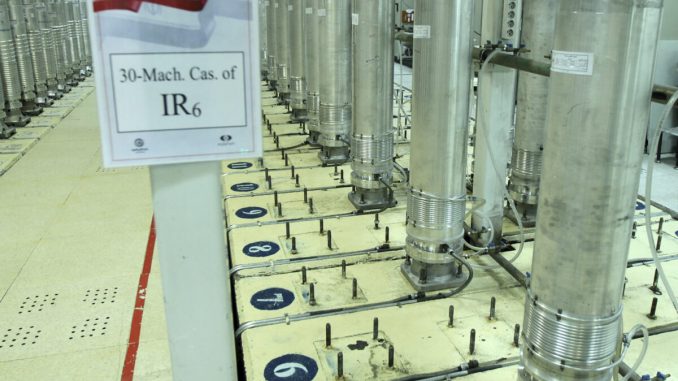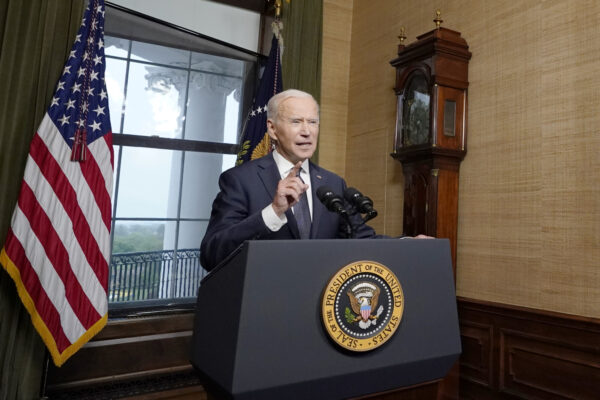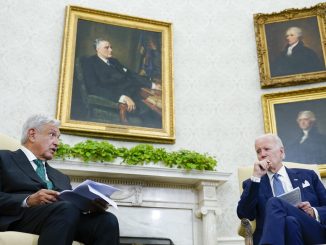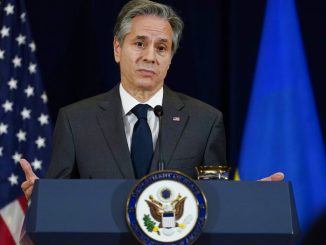
Iran has started enriching uranium at an above-ground nuclear plant at Natanz to 60 percent fissile purity—its highest level ever—the U.N. nuclear watchdog confirmed Saturday.
The International Atomic Energy Agency (IAEA) confirmed announcements made by Iranian officials on Friday that it has started the process of enriching at the plant.
“The Agency today verified that Iran had begun the production of UF6 enriched up to 60 percent U-235 by feeding UF6 enriched up to 5 percent U-235 simultaneously into two cascades of IR-4 centrifuges and IR-6 centrifuges at the Natanz Pilot Fuel Enrichment Plant,” the U.N. watchdog told Reuters in a statement.
UF6 is uranium hexafluoride, the form in which uranium is fed into centrifuges for enrichment.
Reuters also cited parts of an internal IAEA report to member states that elaborated on the process of enrichment.
“According to Iran’s declaration to the Agency, the enrichment level of the UF6 produced at PFEP was 55.3 percent U-235. The Agency took a sample of the produced UF6 for destructive analysis to independently verify the enrichment level declared by Iran. The results of this analysis will be reported by the Agency in due course,” the report said.
The move has complicated talks aimed at reviving Iran’s nuclear deal with major powers as it is a big step toward producing weapons-grade uranium. Weapons-grade levels stand at 90 percent.
Iran had previously only reached 20 percent purity, and that was already a breach of the deal, which says Iran can only enrich to 3.67 percent.
Iran made the step up to 60 percent in response to an explosion that damaged equipment at the larger, underground Fuel Enrichment Plant at Natanz. Tehran has blamed Israel and named a man wanted in connection with the blast.
President Joe Biden on Friday called the move unhelpful, but added that the United States is “pleased” that Iran has agreed to continue talks on the topic of compliance with the 2015 Joint Comprehensive Plan of Action (JCPOA)—known commonly as the Iran nuclear deal—which former President Donald Trump withdrew from in 2018.

“We do not support and do not think it’s at all helpful that Iran is saying it’s going to move to enrich to 60 percent,” Biden said during a joint press briefing with Japanese Prime Minister Yoshihide Suga in Washington.
“We are, though, nonetheless pleased that Iran has continued to agree to engage in discussions—indirect discussions—with us and with our partners on how we move forward and what is needed to allow us to move back into the [nuclear deal] … without us making concessions that we are just not willing to make,” the president added.
The U.S. State Department reiterated earlier this month that the Biden administration won’t offer unilateral incentives to get Iran back to the negotiating table on the nuclear pact between Iran and six major powers under which Tehran agreed to limit its nuclear program in return for the easing of U.S. and other economic sanctions.
The deal made it harder for Iran’s atomic program to be used to produce nuclear weapons, an ambition Tehran denies. Trump pulled the United States out of the deal in 2018 and reimposed sanctions on Iran, saying at the time that America would “not be held hostage to nuclear blackmail.” He called it “a horrible one-sided deal” that is “defective at its core.”
Reuters contributed to this report.





Be the first to comment